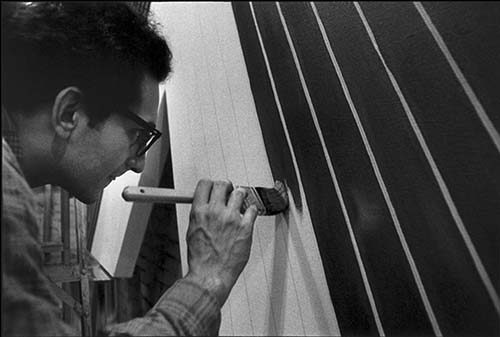
Frank Stella, the Abstract Expressionist's print master
ArtWizard 18.11.2019
“No art is any good unless you can feel how it's put together. By and large it's the eye, the hand and if it's any good, you feel the body. Most of the best stuff seems to be a complete gesture, the totality of the artist's body; you can really lean on it.”
Frank Stella, born 1936, is one of the most prominent Post-War American painters. His striped works, monumental prints and revolutionary approach to materials have had a profound impact on the world of abstract art. His constantly evolving style, as well as the very particular and unique minimalism of his works in the late 1950s and early ’60s, paved the way to the maximalist color compositions later in his career. The artist is often regarded as a rule-breaker. His approach to materials does not have limits and combine all different elements, starting from car paint, cast aluminium, fibreglass, and the latest 3D-printing techniques.
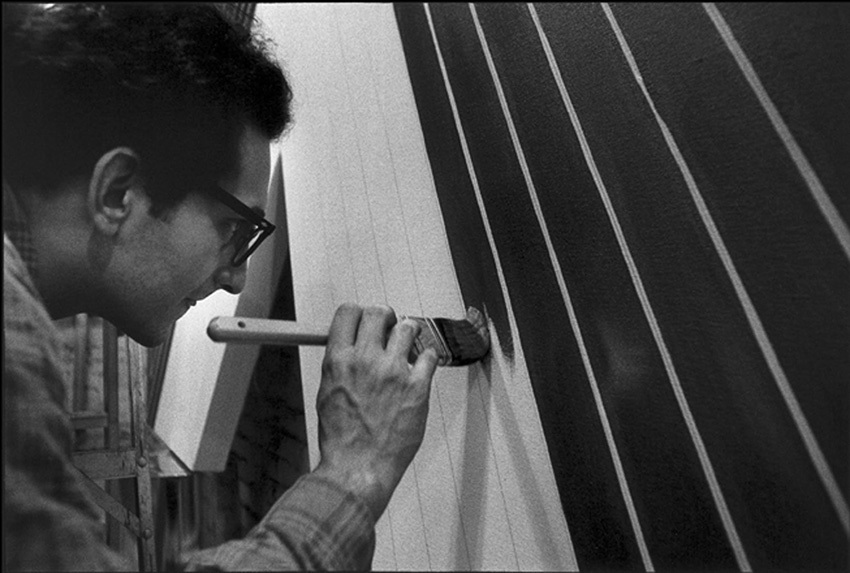
Franck Stella making The Black Painting
Franck Stella has Italian roots, as his family’s provenance is from Sicily. The artist’s father was a doctor, while his mother was an artistically inclined housewife, who attended fashion school and painted landscapes. His father was quite influential and insisted that the young Stella learn the importance of physical labour. Stella’s first experience of painting was painting houses and boats on his father orders, something that had influence over his artistic career, as he used these techniques and materials later on in his art.
In his early adolescent years, Stella acquired a reputation of a fight person. He attended the prestigious Phillips Academy, where he once lost three teeth in a dormitory scuffle. His fiery attitude, however, was combined with a sharp intelligence, as he majored history later on at Princeton University. At this period he began to paint and engage in art.
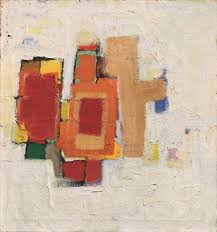
Frank Stella, Princeton II, 1956
When he graduated in 1958, Stella moved to New York city, claiming: “I came here because it was the place where you could see art that I was interested in — it’s as simple as that”. It was there, that he encountered the work of the Post War Abstract Expressionists, including Jackson Pollock and where he rented his first New York apartment. His early art was highly influenced exactly by the Abstract Expressionists. The artist liked to comment that, he “wouldn’t have bothered becoming an artist if I didn’t like the artists of that generation so much.” Stella was influenced not only by the artworks of Pollock, but also by the flatness of the works of Barnett Newman and the style of Jasper Johns. From the latter, Stella was inspired to use the stripes in his paintings that became later on his trademark in most of his compositions.
Stella was one of the contemporary artists first using printmaking in his works. He began to make an engagement with printmaking in the mid 1960s, working with master printer Kenneth Tyler, who convinced Stella to make his first prints by filling a “Magic Marker” that was the artist’s preferred drawing implement, with lithography fluid. His abstract prints proved as innovative as his canvas works, employing a vast array of techniques, including lithography, screen-printing, etching, and offset lithography. Printed by “Waddington Custot” galleries, the artist’s “Illustrations after El Lissitzky’s” and “Had Gadya” series is an excellent example of Stella’s diversity as a print maker. His artworks were combining hand colouring with lithographic technique, linoleum blocks and silkscreen, making unique combinations and vision.

Frank Stella, Untitled, 1960
The art made by Stella was greatly influencing his personal life. From 1958-60, he shared a loft with the photographer Hollis Frampton and sculptor Carl Andre, and according to the testimonies of both, they have been “educating each other”.
When he moved to New York, Stella was still painting houses to pay rent, and continued to use the house painter’s brush and enamel when making his “Black Paintings” (1958-60).
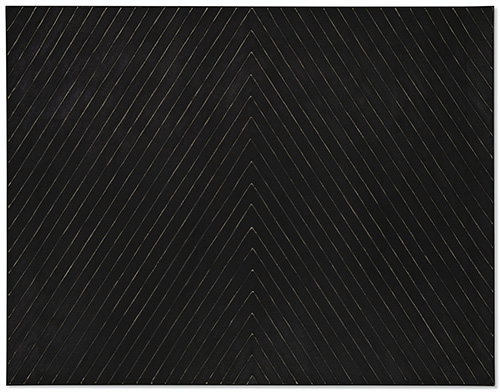
Frank Stella, Point of Pines, 1959
Stella was a pioneer in his approach to canvasses. The artist approached them as he would approach a house, as a space to be filled by increasingly proximate concentric lines. In his “Copper Paintings” 1960-61, Stella used a barnacle-inhibiting paint he had employed the previous summer on the hull of his father’s boat. Named after the brand of household paint Stella has used to create these artworks, the series “Benjamin Moore” impressed Andy Warhol to such an extent that he bought them all.
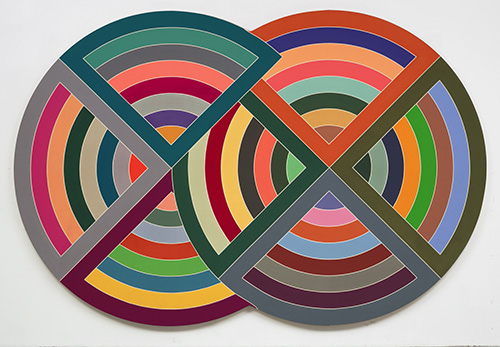
Frank Stella, Firuzabad, 1970
Stella’s works are often called “pinstripe paintings”, though the implied regularity is inaccurate. When working, the artist doesn’t measure out lines, as many critics have presumed, but works freehand, subtly deviating from a perfect straight line with natural bows in pliable stretched canvas.
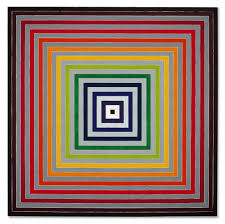
Frank Stella, Lettre sur les sourds et muets I, 1974
The fame as an artist came to Stella at a very early age. His work was featured in an exhibition at the Museum of Modern Art (MoMA) before he was 25, and he had his first retrospective at the museum when he was just 34, far younger than many artists to have received the same honour. Hospitalised for knee surgery when the show opened, Stella used the occasion, not to take stock, but to produce reams of drawings. “I don’t know how to draw in the sense of pure drawing. I need to go to the material stage as quickly as I can,” he concluded.
Concerned by a dissonance between painted lines and the shape of the canvas, Stella began to remove sections of paintings that seemed superfluous. The earliest examples of such approach are his “Aluminium Paintings” (1960) and “Copper Paintings” (1960-1961), later followed by works that extended the concept of the shaped canvas, including the Irregular “Polygon Canvases” (1965-67) and the “Protractor Series” (1967-71). Over the next decade, Stella introduced relief into his art, describing his approach as “maximalist’ painting”.
The art work of Stella was always influenced by the literature. In 1983, Stella became a Professor of Poetry at Harvard University.
An example of the literature influencing his works is the fact that the names of Stella works are also significant and unlike some other abstract painters, as they are loading his works with emotional meaning.
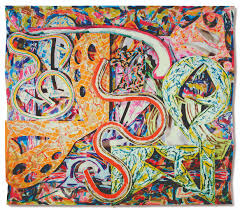
Frank Stella, Talladega II, 1982
The names of the “Black Paintings” series was chosen based on provocative German titles related to National Socialism and the Nazi Party. The artist said in a comment that: “The Black Paintings were dark, very dark. Some of them needed dark titles.” Another example of such names are his “Had Gadya” series, where the names of Stella’s prints follow the lines of a traditional Israeli song, with each new line resulting from the preceding paragraph of this song. Though the meaning of this religious song is open to interpretation, it is commonly read as a symbolic reference to the nations that have suppressed Israel throughout history.
Stella continues to work in New York, NY and commutes to his studio in Rock Tavern, New York. Today, Stella’s works are held in the collections of the Metropolitan Museum of Art in New York, the Kunst museum Basel, the Art Institute of Chicago, the National Gallery of Art in Washington, D.C., and the Tate Gallery in London, among others.
